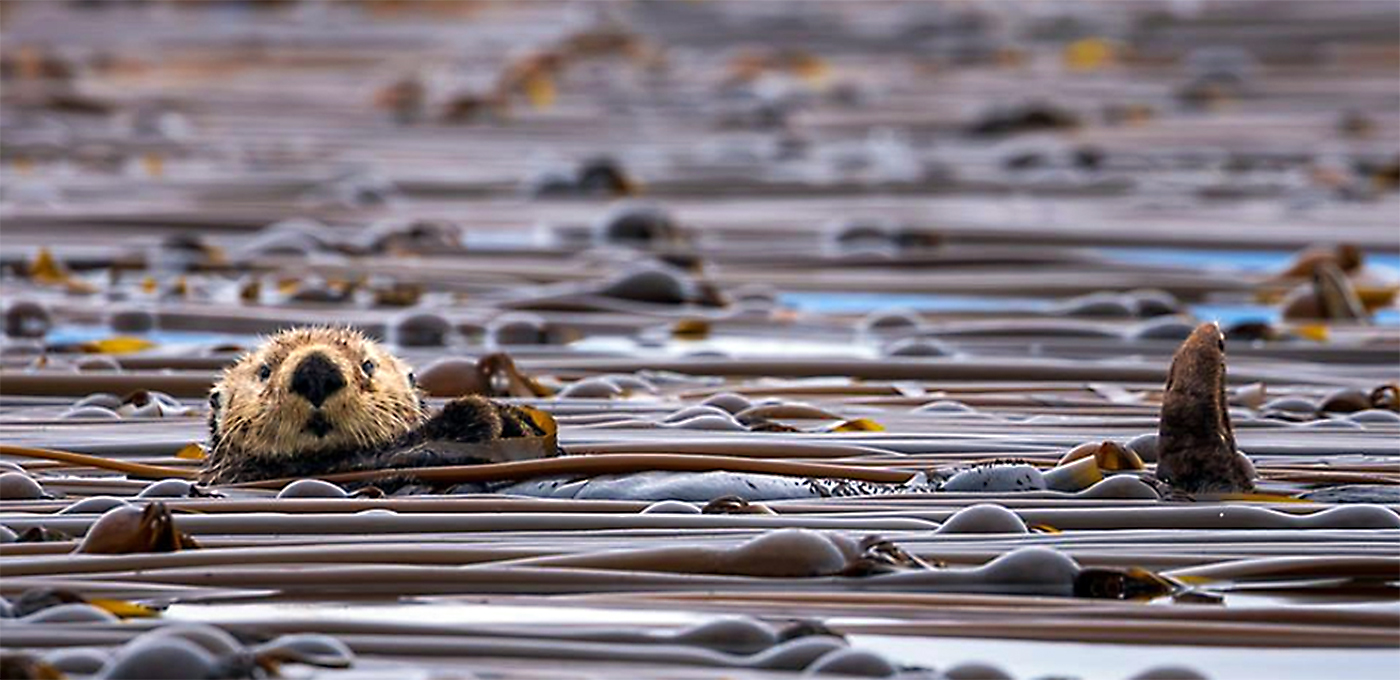Author: Zoe Jennings
Photo: Thank you to Josh Deleenheer for his photo.
Scientific Name: Enhydra lutris
Size Range: Length 1.2-1.5 meters for males, 1-1.4 meters for females; Mass 22-45 kg for males, 14-33 kg for females.

Ollie the lone resident of Race Rocks near Pedder Bay, British Columbia.
Identifying Features: Sea otters are among the smallest marine animals but are actually the largest in the weasel family. Their fur is the main protection they have against the cold water that is their home; it is estimated that they have 100,000 hairs per square centimetre, they have the densest fur of any animal on Earth. They have webbed feet and strong back legs adapted for swimming and a flat, large head, black eyes, and tiny ears. Sea otters spend most of their time on their backs floating around and are normally spotted in large groups. Their distinctive colours are brown with a white face.
Habitat: Approximately 6000 sea otters live in B.C around the central coast by Bella Bella and the west coast of Vancouver Island. Near Vancouver, the only sea otters are living in the Vancouver Aquarium (4 of them). They populate reefs, fjords, kelp forests, and bays and coastal waters near islands in the North Pacific Ocean. In other areas in the world, there are larger populations like Russia and Alaska, in Russia, there are 22,500 sea otters, and in Alaska, there are 71,500, but in California, there are 2,500 and only 550 in Washington. In their ecosystems, sea otters are a keystone species because they have such a substantial impact on the habitat around them. Kelp forests thrive when sea otters control the sea urchin population.
Food (Prey): Sea otters eat a variety of seafood: clams, prawns, squid, crabs, chitons, snails, abalone, sea star legs, mussels, and sea urchins. In certain areas, they eat various types of fish. Sea otters have insufficient underwater vision so they have to dive using their sense of touch to find food with their front paws which are very sensitive. While eating they float on their backs and use their stomachs as tables. Sometimes they use rocks to crush food with hard shells. Up to twenty-five percent of their body weight is eaten per day by sea otters, because they need the energy to keep their body temperature constant in the cold ocean. Their fur is the only thing that keeps them warm because they have no insulating body fat. Compared to a similar-sized land mammal, a sea otter’s metabolic rate is two or three times larger.
Predators: In kelp forests, sea otters are keystone predators, but they are eaten by bald eagles, great white sharks, orcas, and other great predators. Oil spills are a major threat to sea otters because when there is a spill, the oil breaks down the natural oil in their fur. This leads to the loss of their ability to insulate themselves. If they aren’t rescued after a spill they can die due to hypothermia. In the 1700s and 1800s, sea otter’s predators were humans; because of their thick pelts, humans desired their fur for coats and were hunted to extinction on the coast of B.C. The actual sea otters around here now are the descendants of Alaskan sea otters when 89 were relocated from 1969-1972.
Life Cycle: Sea otters become sexually mature at the age of 3 for females and 5-6 years for males. They live between 15-20 years old. Most pups are born between April and July but they can give birth at other times of the year as well. Sea otters usually give birth to one pup at a time commonly in the water and they float on their backs while nursing. Pups have yellowish-brown fur and only weigh about 2 kg when born. Sea otters are pregnant for 6 to 9 months.
Fun Facts:
- Sea otters can live their whole lives without ever leaving the ocean.
- Sea otters hold paws to keep themselves from drifting apart while sleeping.
- They also wrap themselves in kelp while sleeping so they don’t float away since they have to sleep on the surface.
References:
Sea Otters. (n.d.). In Oceana. Retrieved from https://oceana.org/marine-life/marine-mammals/sea-otter
Sea Otters. (n.d.). In Vancouver Aquarium. Retrieved from https://www.vanaqua.org/education/aquafacts/sea-otters
Sea Otter. (n.d.). In VI-Wilds Vancouver Island Wilderness and Historical Conservation. Retrieved from http://www.geog.uvic.ca/viwilds/iw-otter.html
Sea Otter. (n.d.). In Oceana Canada. Retrieved from https://oceana.ca/en/marine-life/canadian-marine-life-encyclopedia/sea-otter
Ten Facts About Sea Otters. (2010, December 13). In World Wildlife Foundation. Retrieved from https://www.worldwildlife.org/blogs/good-nature-travel/posts/ten-facts-about-sea-otters
